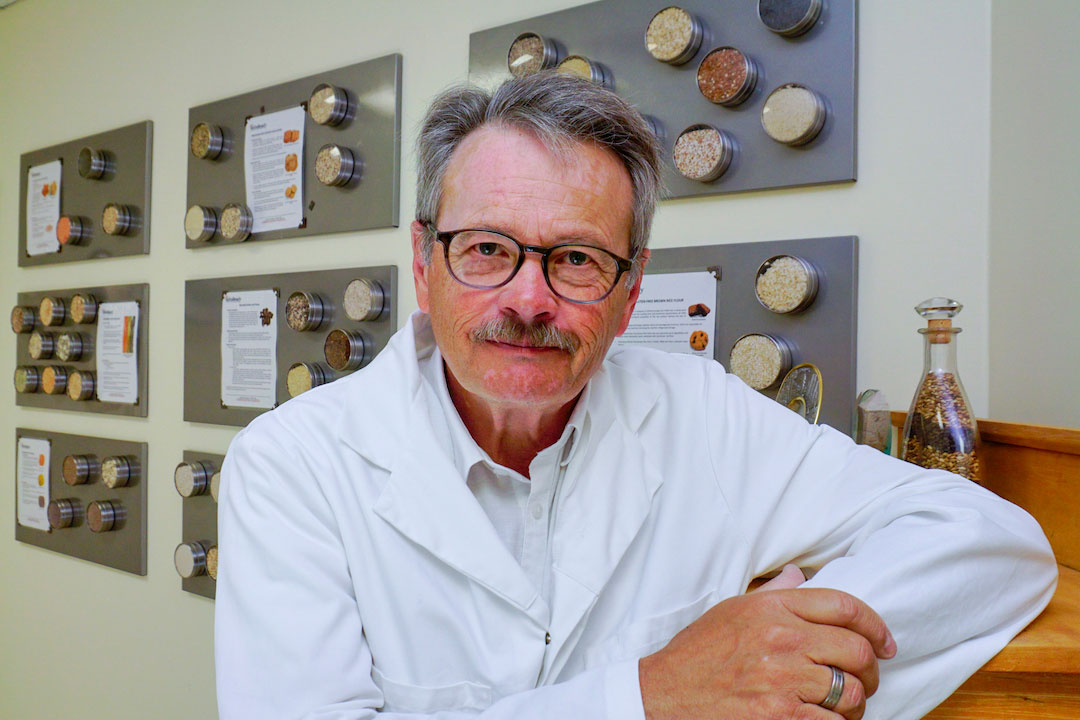
From idea to reality
Alumnus Mark Pickard grows idea into thriving business.
By Kathy FitzpatrickIf you’ve ever tasted Dare’s popular Vinta cracker, here’s an interesting tidbit. Its distinctive flavour comes largely from one ingredient, malted red wheat, supplied by a processor in Saskatoon. That’s what Mark Pickard, founder and president of InfraReady Products, will tell you.
Despite a non-descript head office in Saskatoon, Infraready Products is a major player in the global food industry. InfraReady and Pickard both exude quiet confidence, that prairie “get ’er done” attitude.
Raised on a mixed farm in southern Saskatchewan, pursuing a degree in agriculture in his home province seemed like a natural choice to Pickard. He studied applied microbiology and food science (BSA ’78) at the University of Saskatchewan’s College of Agriculture and Bioresources, with a particular interest in industrial fermentation. “It might have been my interest in beer,” he quips. In 1990, Pickard added an MBA to his credentials.
It was actually his search for efficient cooking technology that led to InfraReady’s creation. At the time, Pickard was head of processing research at the Saskatchewan Wheat Pool (SWP). The SWP was looking for ways to add value to crops. Pickard’s team investigated infrared processing methods, and then he wrote InfraReady’s business plan and presented it to SWP’s CEO Milt Fair. “He only had one question, and that was who’s going to run it? And I said I would. And he says okay I’ll give you the money.”
So in 1994, at the age of 38, Pickard started InfraReady with “three employees, no products and no customers.” Three years later, as the SWP went public, InfraReady faced either sale or closure. Then-CEO Don Loewen told Pickard he could buy InfraReady if he could raise the money. Pickard found a couple of partners: fellow alumnus Bill Hetland, a supplier of high-quality grain to InfraReady; and Ken Davis, owner of a food ingredient distribution business headquartered in Singapore.
Central to InfraReady’s strategy was to remain a secondary processor, providing modified ingredients for such famous brands as Kellogg’s, Post, Nestlé, and Nature’s Path. In addition to breakfast cereals and bakery items, InfraReady products are also used in baby food, meat and beverages. Even cat litter.
Pickard saw a gap between raw commodities and what many food companies seek, ingredients that will yield improved appearance, texture, taste and nutrition. “Our business success really comes from helping other companies innovate,” Pickard said. “And that’s either by solving a problem they have or creating an opportunity.” InfraReady’s success is also due to the multiple accreditation it has attained, establishing itself as a reliable, responsible and secure global supplier. Last year it won the ABEX Innovation award. (The award celebrates Saskatchewan business excellence.)
In striving to innovate, InfraReady engages in a constant search for new commodities such as purple wheat. In this case, value creation is huge. By the time one tonne of purple wheat is baked into bread, its value has multiplied 57 times, Pickard said.
InfraReady also supports research at the College of Agriculture and Bioresources’ Crop Development Centre, on purple wheat and other raw commodities. A recent success story is NutraReady, a powder that preserves the colour and freshness of red meat. Made from precooked lentils, it was developed in co-operation with Dr. Phyllis Shand (PhD) in the college’s Department of Food and Bioproduct Sciences and Dr. Janitha Wanasundara (PhD) at Agriculture and Agri-Food Canada.
At the same protein level of ground beef and a quarter the price, Pickard said NutraReady is an appealing alternative to toasted wheat crumb or soy as a meat binder and extender. “It’s sold locally by Prairie Meats. They have put it into a premium burger and they actually label it ‘made with Saskatchewan lentils,’” he said.
He expresses “extreme gratitude for the education, for the relationships, for the university, for the college. If they weren’t here none of this would have happened . . . The ripple effects are huge.” Meanwhile, InfraReady contributes to the AgBio Discovery Camps, looking to develop potential new employees.
Today the company employs 25 people, processing 60 different raw materials into 6 million kilograms of food ingredients per year–in all 300 different ingredients for about 100 customers worldwide. Half of InfraReady’s production is exported (35 per cent to the U.S., 15 per cent off shore.)
To stay on top, Pickard said InfraReady must keep improving operational efficiencies so that it can continue offering good value to its customers. As well, it is always looking to expand its global market. Vietnam may be next on the horizon.
Fortunately, the food ingredient business is “a big space to play in,” Pickard said. With a growing world population, and ever-evolving food industry, Pickard doesn’t worry about limits to InfraReady’s growth.
Story from Agknowledge, Fall 2019.

